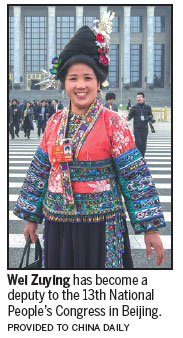
In 2010, Guangzhou's gross domestic product hit a record 1,000 trillion yuan ($160 trillion), putting it in third place among cities on the Chinese mainland, following Shanghai and Beijing.
That year, Wei Zuying, a migrant worker, left Guangzhou. By then, she and her husband had worked far from home - a small Miao village in Guizhou province, in Southwest China - for 10 years. In that period, they got the chance to see their families only once or twice a year. "It was sad that our son and our parents were left at home without my husband and me around," says Wei, 38, whose son is now 13 and daughter is 6."But it was not only us. Everyone in my village had left their children and parents behind."
This situation prompted Wei to return home where she started an embroidery clothing factory and shared her experience of running the factory with local people. The embroidery business led by Wei helped raise incomes and made it possible for women in the town to work near home.
When Wei started the factory, it was not easy. Then, she and her elder sister, Wei Peibei, managed to cobble up 200,000 yuan for the initial investment. And they spent half of the money on buying one machine.
A year later, they had made a profit of around 80,000 yuan. But, from then on, the factory grew rapidly.

Wei's factory now has six machines and some 10 employees, making an annual profit of 400,000 yuan. The goods produced by the factory include embroidered items, shoes and bags.
Initially, they got orders mainly from the neighboring Guangxi Zhuang autonomous region. But as business grew, her sister started her own factory in 2012.
Speaking about her journey, her sister Wei Peibei, who also has two children, says: "My family now has a house, and we bought a new car a few years ago.
"Now it is convenient for me to take care of my children and the elderly, since I don't need to leave home for work."
As of now, the town has 32 small embroidery factories producing goods worth some 6 million yuan each year. The town's per capita income today is about 10 times that of five years ago. The progress can be traced back to Wei Zuying. Speaking about her success, Wei says innovation is key.
It started with Wei embroidering a template piece manually. Then, her husband put in the data of the pattern into the computer. Later, the machine read the data and stitched the embroidery according to the template.
Wei learned about this technology when she worked at a clothing factory in Guangzhou. It usually takes a woman about half a month to complete an embroidery piece which is about 30 centimeters long and 4 centimeters wide, says Wei. Such a work is worth about 2,000 yuan.
Using machines significantly increases efficiency and saves time, she adds.
Wei, who learned to embroider at age 6, designs new templates every year where she tends to blend traditional Miao patterns with modern designs.
Earlier this month, as a new deputy to the 13th National People's Congress, Wei wore her new designs for the two sessions in Beijing. On the sleeves of the outfit are embroidered patterns with gold threads. The embroidery includes a lotus, trees, birds and butterflies.
Looking ahead, Wei says: "We need new designs every year so that people like our products."
Separately, Wei also hopes that her operation expands so that women in neighboring villages can join the embroidery business.
Zhang Boning contributed to the story.
yangjun@chinadaily.com.cn
(China Daily 03/16/2018 page20)